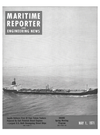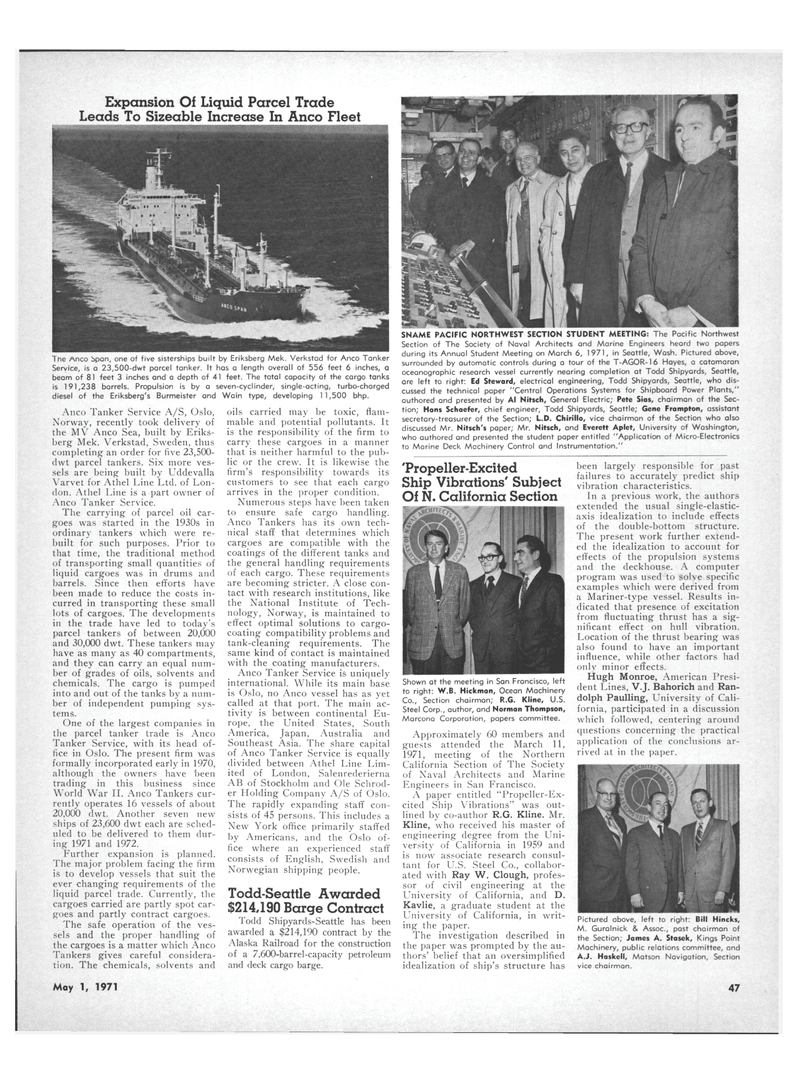
Page 43: of Maritime Reporter Magazine (May 1971)
Read this page in Pdf, Flash or Html5 edition of May 1971 Maritime Reporter Magazine
Expansion Of Liquid Parcel Trade
Leads To Sizeable Increase In Anco Fleet
The Anco Span, one of five sisterships built by Eriksberg Mek. Verkstad for Anco Tanker
Service, is a 23,500-dwt parcel tanker. It has a length overall of 556 feet 6 inches, a beam of 81 feet 3 inches and a depth of 41 feet. The total capacity of the cargo tanks is 191,238 barrels. Propulsion is by a seven-cyclinder, single-acting, turbo-charged diesel of the Eriksberg's Burmeister and Wain type, developing 11,500 bhp.
Anco Tanker Service A/S, Oslo,
Norway, recently took delivery of the MV Anco Sea, built by Eriks- berg Mek. Verkstad, Sweden, thus completing an order for five 23,500- dwt parcel tankers. Six more ves- sels are being built by Uddevalla
Varvet for Athel Line Ltd. of Lon- don. Athel Line is a part owner of
Anco Tanker Service.
The carrying of parcel oil car- goes was started in the 1930s in ordinary tankers which were re- built for such purposes. Prior to that time, the traditional method of transporting small quantities of liquid cargoes was in drums and barrels. Since then efforts have been made to reduce the costs in- curred in transporting these small lots of cargoes. The developments in the trade have led to today's parcel tankers of between 20,000 and 30,000 dwt. These tankers may have as many as 40 compartments, and they can carry an equal num- ber of grades of oils, solvents and chemicals. The cargo is pumped into and out of the tanks by a num- ber of independent pumping sys- tems.
One of the largest companies in the parcel tanker trade is Anco
Tanker Service, with its head of- fice in Oslo. The present firm was formally incorporated early in 1970, although the owners have 'been trading in this business since
World War II. Anco Tankers cur- rently operates 16 vessels of about 20,000 dwt. Another seven new ships of 23,600 dwt each are sched- uled to be delivered to them dur- ing 1971 and 1972.
Further expansion is planned.
The major problem facing the firm is to develop vessels that suit the ever changing requirements of the liquid parcel trade. Currently, the cargoes carried are partly spot car- goes and partly contract cargoes.
The safe operation of the ves- sels and the proper handling of the cargoes is a matter which Anco
Tankers gives careful considera- tion. The chemicals, solvents and oils carried may be toxic, flam- mable and potential pollutants. It is the responsibility of the firm to carry these cargoes in a manner that is neither harmful to the pub- lic or the crew. It is likewise the firm's responsibility towards its customers to see that each cargo arrives in the proper condition.
Numerous steps have been taken to ensure safe cargo handling.
Anco Tankers has its own tech- nical staff that determines which cargoes are compatible with the coatings of the different tanks and the general handling requirements of each cargo. These requirements are becoming stricter. A close con- tact with research institutions, like the National Institute of Tech- nology, Norway, is maintained to effect optimal solutions to cargo- coating compatibility problems and tank-cleaning requirements. The same kind of contact is maintained with the coating manufacturers.
Anco Tanker Service is uniquely international. While its main base is Oslo, no Anco vessel has as yet called at that port. The main ac- tivity is between continental Eu- rope, the United States, South
America, Japan, Australia and
Southeast Asia. The share capital of Anco Tanker Service is equally divided between Athel Line Lim- ited of London, Salenrederierna
AB of Stockholm and Ole Schrod- er Holding Company A/S of Oslo.
The rapidly expanding staff con- sists of 45 persons. This includes a
New York office primarily staffed by Americans, and the Oslo of- fice where an experienced staff consists of English, Swedish and
Norwegian shipping people.
Todd-Seattle Awarded $214,190 Barge Contract
Todd Shipyards-Seattle has been awarded a $214,190 contract by the
Alaska Railroad for the construction of a 7,600-barrel-capacity petroleum and deck cargo barge.
SNAME PACIFIC NORTHWEST SECTION STUDENT MEETING: The Pacific Northwest
Section of The Society of Naval Architects and Marine Engineers heard two papers during its Annual Student Meeting on March 6, 1971, in Seattle, Wash. Pictured above, surrounded by automatic controls during a tour of the T-AGOR-16 Hayes, a catamaran oceanographic research vessel currently nearing completion at Todd Shipyards, Seattle, ore left to right: Ed Steward, electrical engineering, Todd Shipyards, Seattle, who dis- cussed the technical paper "Central Operations Systems for Shipboard Power Plants," authored and presented by Al Nitsch, General Electric; Pete Sias, chairman of the Sec- tion; Hans Schaefer, chief engineer, Todd Shipyards, Seattle; Gene Frampton, assistant secretary-treasurer of the Section; L.D. Chirillo, vice chairman of the Section who also discussed Mr. Nitseh's paper; Mr. Nitsch, and Everett Aplet, University of Washington, who authored and presented the student paper entitled "Application of Micro-Electronics to Marine Deck Machinery Control and Instrumentation." 'Propeller-Excited
Ship Vibrations' Subject
Of N. California Section
Shown at the meeting in San Francisco, left to right: W.B. Hickman, Ocean Machinery
Co., Section chairman; P..G. Kline, U.S.
Steel Corp., author, and Norman Thompson,
Marcona Corporation, papers committee.
Approximately 60 members and guests attended the March 11, 1971, meeting of the Northern
California Section of The Society of Naval Architects and Marine
Engineers in San Francisco.
A paper entitled "Propeller-Ex- cited Ship Vibrations" was out- lined by co-author R.G. Kline. Mr.
Kline, who received his master of engineering degree from the Uni- versity of California in 1959 and is now associate research consul- tant for U.S. Steel Co., collabor- ated with Ray W. Clough, profes- sor of civil engineering at the
University of California, and D.
Kavlie, a graduate student at the
University of California, in writ- ing the paper.
The investigation described in the paper was prompted by the au- thors' belief that an oversimplified idealization of ship's structure has been largely responsible for past failures to accurately predict ship vibration characteristics.
In a previous work, the authors extended the usual single-elastic- axis idealization to include effects of the double-bottom structure.
The present work further extend- ed the idealization to account for effects of the propulsion systems and the deckhouse. A computer program was used to solve specific examples which were derived from a Mariner-type vessel. Results in- dicated that presence of excitation from fluctuating thrust has a sig- nificant effect on hull vibration.
Location of the thrust bearing was also found to have an important influence, while other factors had only minor effects.
Hugh Monroe, American Presi- dent Lines, V.J. Bahorich and Ran- dolph Paulling, University of Cali- fornia, participated in a discussion which followed, centering around questions concerning the practical application of the conclusions ar- rived at in the paper.
Pictured above, left to right: Bill Hincks,
M. Guralnick & Assoc., past chairman of the Section; James A. Stasek, Kings Point
Machinery, public relations committee, and
A.J. Haskell, Matson Navigation, Section vice chairman.
May 1, 1971 47

 42
42

 44
44
